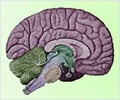A red colored dye obtained from Lichens may help to reduce the abundance of small toxic protein aggregates in Alzheimer's disease, reveals study.

O4 binding to small aggregates promotes their conversion into large, mature plaques which researchers assume to be largely non-toxic for neuronal cells.
Protein misfolding is considered to be the cause of Alzheimer's, Parkinson's and also Huntington's disease. In a multistep process, proteins misfold and accumulate into large extra- or intracellular plaques.
Erich Wanker and his team of researchers from Berlin assume that small misfolded protein aggregates that are precursors of mature plaques are toxic for nerve cells and are the reason why they are eventually destroyed.
The synthetic dye methylene blue is currently being tested in clinical trials. This dye also seems to stimulate the formation of large plaques in a way similar to O4. Other therapeutic approaches tested in clinical trials which aim at eliminating small precursor aggregates have so far not led to a significant improvement of disease symptoms.
However, it still remains to be seen whether the blue dye O4 can also be effective against small amounts of misfolded proteins in the brains of Alzheimer's patients and whether the accelerated formation of larger plaques can indeed reduce the signs and symptoms of Alzheimer's disease in humans.
Source-ANI
 MEDINDIA
MEDINDIA



 Email
Email








